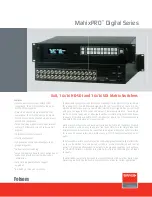
Confidential and proprietary information of Extreme Networks. © 2011 Extreme Networks, Inc.
All rights reserved. DRAFT. October 20, 2011
Building a SummitStack Configuration
Summit Family Switches Hardware Installation Guide
156
NOTE
Additional types of stacking cables may have been released since this guide was published. Contact your
Extreme Networks sales representative for the most recent information about available cables.
Placing Summit Family Switches for
Stacked Operation
This section summarizes the recommended best practices for installing Summit switches for a
SummitStack configuration. For detailed information about how to configure and manage the stack
and how a stack operates, refer to the
ExtremeXOS Concepts Guide
.
When you install switches for a SummitStack configuration, follow these recommendations:
●
Use the shortest possible stacking cables to connect the switches in the stack; this reduces the
likelihood that the stacking cables might be accidentally damaged or disconnected. Stacking cables
are available in lengths from 0.3 meters to 100 meters (see
Table 50
).
●
When possible, place all switches for the stack in the same rack or in adjacent racks; this facilitates
using shorter stacking cables.
●
The stack master is the switch through which you will perform the initial stack configuration, using
the console port. For simplicity and ease of connecting the stacking cables, plan to designate the top
switch in a vertical physical stack as the stack master. If switches are installed in several adjacent
racks, place the stack master at one end of the row.
●
Physically locate the intended master and backup nodes adjacent to each other, and connect these
switches directly to each other.
●
For easier software configuration of the stack, connect the stacking cables in the order and
arrangement shown in the tables that accompany the examples starting
on page 160
.
●
On the stack master switch, connect the Ethernet management port to your management network.
●
To provide management access to the stack in case of a failure in the master switch, connect all
switches that will participate in redundancy to your management network using the Ethernet
management port on each switch.
●
Because of the weight of the cable, Extreme Networks strongly recommends the use of cable
management hardware to support the cables and provide strain relief at the connectors when you
use the SummitStack 128G cable, SummitStack 64G cable, or SummitStack 128G/64G cable. (See
“Connecting Stacking Cables” on page 171
.)
Using the SummitStack-V Feature
The dedicated stacking ports (either fixed or on installed VIMs or stacking modules) are called
native
stacking ports. The SummitStack-V feature allows you to reconfigure one or two 10-Gbps Ethernet data
ports to operate as stacking ports. When these ports are enabled to support stacking, they are called
alternate
stacking ports. This feature allows you to use less expensive cables to connect the switches in a
stack. Because copper and fiber Ethernet ports support longer cable distances, this feature also allows
you to extend the physical distance between stack nodes. The SummitStack-V feature supports stack
nodes on different floors in a building or in different buildings on a campus.
















































